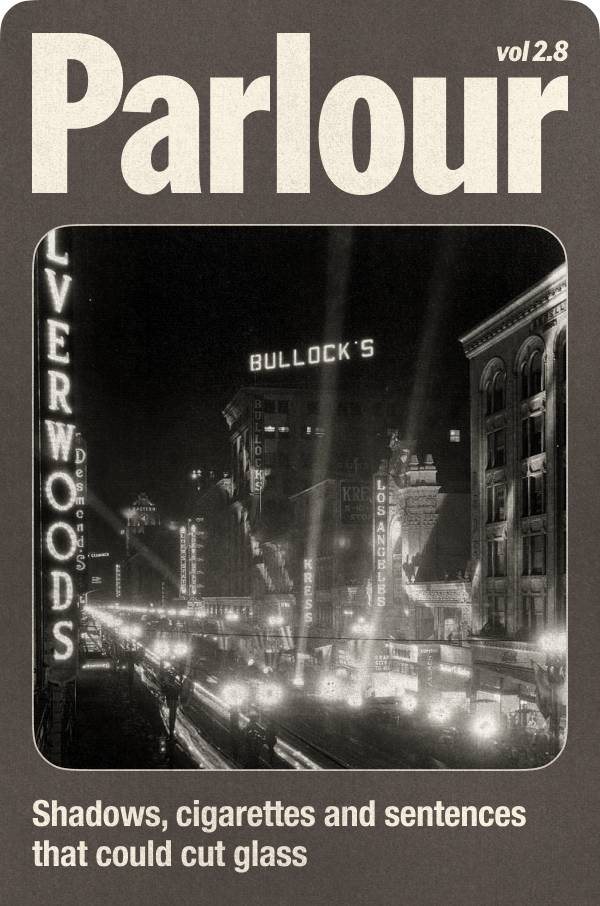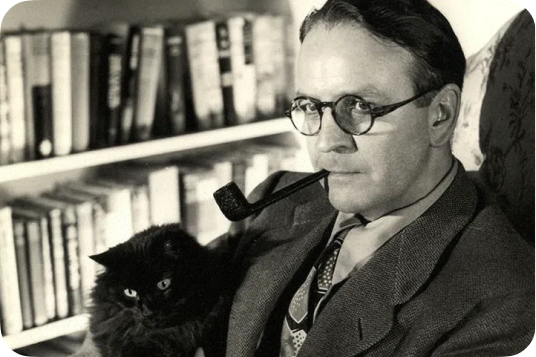


"It seemed like a nice neighborhood to have bad habits in."
Raymond Chandler wrote that line in 1939, and it still lands like a perfectly thrown punch 80+ years later. It's not loud or aggressive. But it does something that most conversations don't have today. It's visual, has feeling, depth…
The Golden Age of Hollywood screenwriters, especially the film noir masters like Chandler, Billy Wilder, and Dorothy Parker, were just built different. They perfected dialogue like it was precision weaponry… and this noir approach can transform how you speak today. Every line was crafted to cut through the noise and create an impression. They knew that the right metaphor, with the perfect timing, could shift the energy in a whole room.
And it wasn't by accident. These writers had a system that turned ordinary observations into linguistic gold. Chandler called it lateral thinking applied to language. Here's how they did it, and how you can too.
Issue forwarded by a friend? Subscribe here.

Chandler's 3-part structure for memorable metaphors is simple and very effective:
For example, Chandler had a line: "She was the kind of blonde who'd make a bishop kick a hole in a stained glass window." If you break it down, the target was her appeal, the bridge is religious irreverence, and the sensory link is that image of destruction. It works because your brain has to make three connections altogether. It's what psychologists call "cognitive delight."
But the real wordplay that Chandler loved to work in was called the Contradiction Principle (a term he coined). He paired opposites: high culture with bad behavior, sacred with profane, physical with emotional…
The thing is, when you force the brain to deal with contradictions, you create this emotional space that isn't logic. The listener can feel the metaphor before they even think about it. That's why "She had the kind of eyes that could make a cynic believe in Sunday morning" hits harder than "She had beautiful, innocent eyes."

Howard Hawks' screwball comedy His Girl Friday shows that you can do this in a bunch of different ways. I mean, just watch Rosalind Russell and Cary Grant machine gun through Hawks' dialogue at 180 words per minute (without losing an ounce of wit).
And this is something that I've always wondered about. How is someone so quick? How do they have something to respond with every time?
The trick is having metaphors preloaded. It's called the Immediate Response Protocol. You can't pause mid-conversation. That would be awkward, haha. You have to have your ammunition ready. Wit requires the same preparation as anything else: practice, pattern recognition, and building a vocabulary.
It's a rhythm. Fast strikes work for deflection and surprise: "That idea has about as much staying power as a TikTok trend." Slower builds for emphasis and authority: "His confidence reminded me of expensive cologne; impressive at first, then overwhelming, and eventually something you just want to escape."
Screwball comedy was all about when to strike first vs. when to let it build. Quick wit diffuses tension, where a deliberate metaphor creates it.

Your conversational arsenal needs three components: daily observation, pattern storage, and situational formulas.
There's a game that you can play with yourself that's based on connections. It's an exercise, but it's also a way to rewire how you see the world. Every boring commute can become research. That person in the suit on the subway checking their phone? "He scrolled through emails like he was swiping through dating apps... every notification another potential disappointment." Even when you're paying for coffee, "Coffee shops are basically therapy sessions where you pay $10 to feel better about your life choices."
Build your observation bank. Collect sensory experiences that most people ignore. The specific sound a shoe makes on marble floors. How different types of laughter fill a room. The way people hold their phones. Train your metaphor reflexes.

At networking dinners, when small talk turns strategic, your metaphorical skills become even more valuable. When someone's elevator pitch runs long: "His business plan had the structural integrity of a house built on quicksand."
And because text can lack tone and timing, you need to be immediately clear in emails: "This deadline is coming at us like a Netflix cancellation notice, inevitable and somehow still surprising."
Your metaphors should invite people into the cleverness, not isolate them from it. There's a massive difference between wit and being cruel. Chandler's metaphors elevated his characters, even when they were being cut down. You're not trying to destroy, you're trying to brighten up.
The best metaphors make people think "I wish I said that," not "I'm glad I wasn't the target." Make everyone feel a little more sophisticated, even if you're doing a gentle roasting. Check your ego at the door.

You're not trying to become Chandler, Russell, or Grant. You're using their techniques to become a more elevated version of yourself. The goal isn't to speak like someone from 1940. You're bringing a level of craft to how you speak today.
This matters because mastering metaphorical combat turns you from a passive conversationalist into someone with real presence. You develop the ability to hold your own in any verbal joust while maintaining a little elegance and some wit. Your conversations gain the sophistication and flair of Golden Age Hollywood's sharpest characters, but in your own authentic voice. When you walk into a room, people notice. When you speak, they remember. When you leave, they quote you.
Your words can be as memorable and impactful as any great film dialogue. You just need to know and practice the technique.
Thank you for reading!
Let us know what you thought of this issue by replying directly to this email. Cheers 🥂
Join 2,568 readers 💃🕺🏽